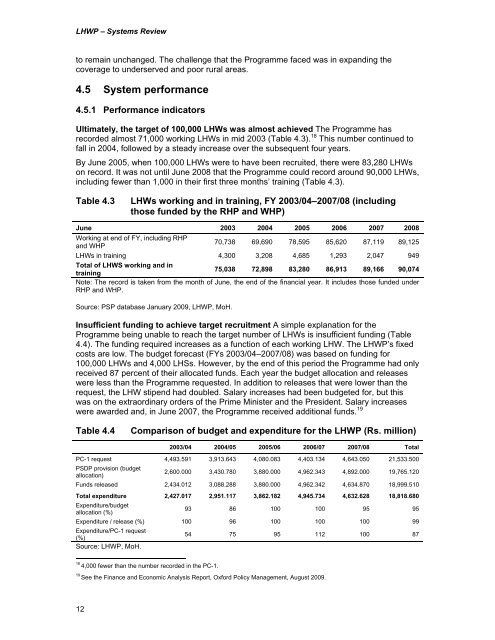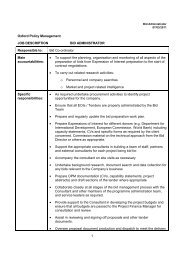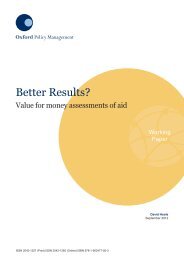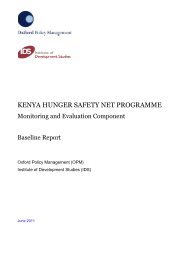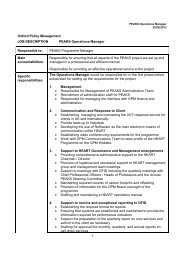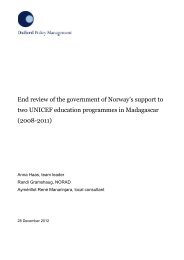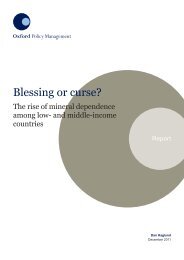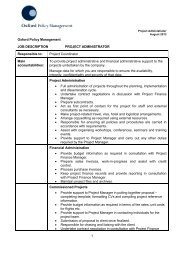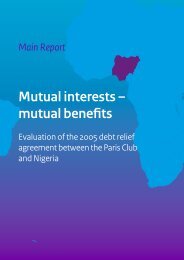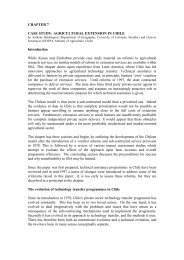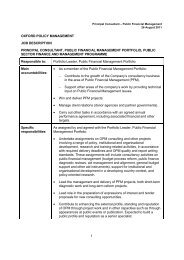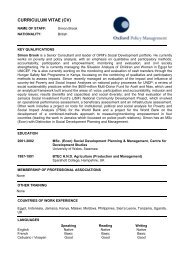LHW Systems Review - Oxford Policy Management
LHW Systems Review - Oxford Policy Management
LHW Systems Review - Oxford Policy Management
Create successful ePaper yourself
Turn your PDF publications into a flip-book with our unique Google optimized e-Paper software.
<strong>LHW</strong>P – <strong>Systems</strong> <strong>Review</strong>to remain unchanged. The challenge that the Programme faced was in expanding thecoverage to underserved and poor rural areas.4.5 System performance4.5.1 Performance indicatorsUltimately, the target of 100,000 <strong>LHW</strong>s was almost achieved The Programme hasrecorded almost 71,000 working <strong>LHW</strong>s in mid 2003 (Table 4.3). 18 This number continued tofall in 2004, followed by a steady increase over the subsequent four years.By June 2005, when 100,000 <strong>LHW</strong>s were to have been recruited, there were 83,280 <strong>LHW</strong>son record. It was not until June 2008 that the Programme could record around 90,000 <strong>LHW</strong>s,including fewer than 1,000 in their first three months’ training (Table 4.3).Table 4.3<strong>LHW</strong>s working and in training, FY 2003/04–2007/08 (includingthose funded by the RHP and WHP)June 2003 2004 2005 2006 2007 2008Working at end of FY, including RHPand WHP70,738 69,690 78,595 85,620 87,119 89,125<strong>LHW</strong>s in training 4,300 3,208 4,685 1,293 2,047 949Total of <strong>LHW</strong>S working and intraining75,038 72,898 83,280 86,913 89,166 90,074Note: The record is taken from the month of June, the end of the financial year. It includes those funded underRHP and WHP.Source: PSP database January 2009, <strong>LHW</strong>P, MoH.Insufficient funding to achieve target recruitment A simple explanation for theProgramme being unable to reach the target number of <strong>LHW</strong>s is insufficient funding (Table4.4). The funding required increases as a function of each working <strong>LHW</strong>. The <strong>LHW</strong>P’s fixedcosts are low. The budget forecast (FYs 2003/04–2007/08) was based on funding for100,000 <strong>LHW</strong>s and 4,000 LHSs. However, by the end of this period the Programme had onlyreceived 87 percent of their allocated funds. Each year the budget allocation and releaseswere less than the Programme requested. In addition to releases that were lower than therequest, the <strong>LHW</strong> stipend had doubled. Salary increases had been budgeted for, but thiswas on the extraordinary orders of the Prime Minister and the President. Salary increaseswere awarded and, in June 2007, the Programme received additional funds. 19Table 4.4Comparison of budget and expenditure for the <strong>LHW</strong>P (Rs. million)2003/04 2004/05 2005/06 2006/07 2007/08 TotalPC-1 request 4,493.591 3,913.643 4,080.083 4,403.134 4,643.050 21,533.500PSDP provision (budgetallocation)2,600.000 3,430.780 3,880.000 4,962.343 4,892.000 19,765.120Funds released 2,434.012 3,088.288 3,880.000 4,962.342 4,634.870 18,999.510Total expenditure 2,427.017 2,951.117 3,862.182 4,945.734 4,632.628 18,818.680Expenditure/budgetallocation (%)93 86 100 100 95 95Expenditure / release (%) 100 96 100 100 100 99Expenditure/PC-1 request(%)54 75 95 112 100 87Source: <strong>LHW</strong>P, MoH.184,000 fewer than the number recorded in the PC-1.19See the Finance and Economic Analysis Report, <strong>Oxford</strong> <strong>Policy</strong> <strong>Management</strong>, August 2009.12


